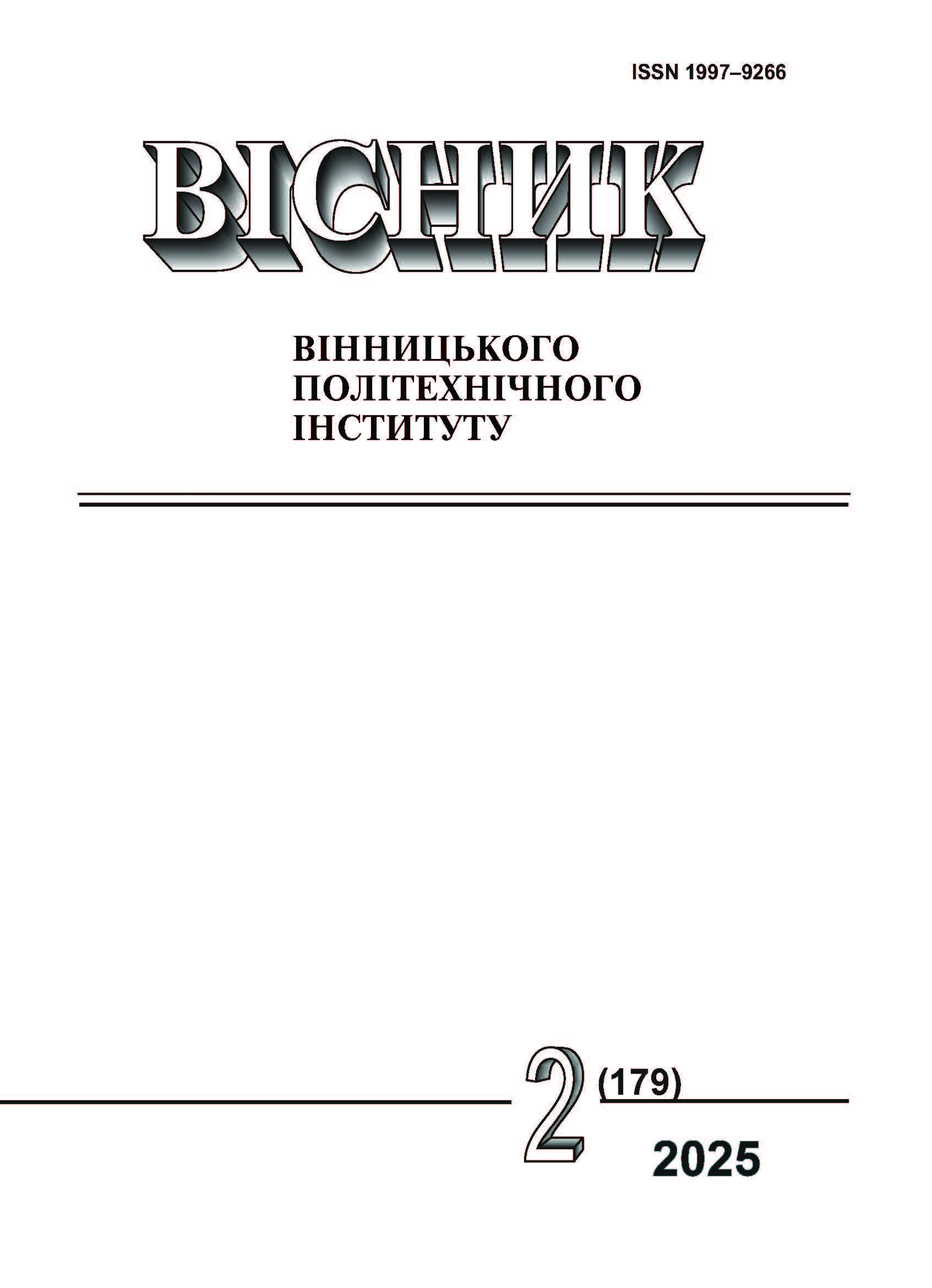ВІЗУАЛЬНО-ІНЕРЦІЙНИЙ SLAM З ВИКОРИСТАННЯМ РОЗШИРЕНОГО ФІЛЬТРА КАЛМАНА ДЛЯ АВТОНОМНОЇ НАВІГАЦІЇ
DOI:
https://doi.org/10.31649/1997-9266-2025-179-2-118-126Ключові слова:
візуально-інерційний SLAM, розширений фільтр Калмана, інерційний вимірювальний пристрій, набір даних KITTIАнотація
Досліджено використання візуально-інерційного SLAM на основі розширеного фільтра Калмана (EKF) для задач автономної навігації. У дослідженні використано дані з KITTI-датасету, що включають зображення зі стереокамери, а також лінійні та кутові швидкості, отримані з інерційно-вимірювального пристрою. Для визначення візуальних орієнтирів запропоновано використовувати ознаки ORB, які характеризуються швидкістю обчислення та стійкістю до змін освітлення, обертання і масштабування. До того ж розроблено алгоритм вибору релевантних орієнтирів, що дозволяє підвищити точність та швидкість роботи SLAM.
Результати серії експериментів продемонстрували, що ефективність роботи системи значною мірою залежить від налаштування співвідношення шумів моделі руху (Q) та сенсорних вимірювань (R). Визначено, що оптимальний діапазон Q/R для досліджуваних наборів даних становить 0,001…0,00001.
Для досягнення балансу між швидкістю та якістю роботи системи досліджено вплив кількості релевантних візуальних ознак у межах від 10 до 120. За результатами експериментів встановлено, що оптимальна кількість орієнтирів становить 50…80, а найкращі результати досягнуто коли Q/R = 0,001 або Q/R = 0,00001 залежно від використаного набору даних. Оцінка точності траєкторії здійснювалася за допомогою метрики ATE (абсолютна похибка траєкторії). Для перевірки використовувалися GPS-дані як ground truth.
Результати підтвердили, що візуально-інерційний SLAM є ефективним інструментом для автономної навігації, особливо в умовах відсутності GPS. Використання EKF у візуально-інерційному SLAM зменшує обчислювальні витрати порівняно з іншими методами, через що він є оптимальним для пристроїв з обмеженими ресурсами, зокрема для мобільних роботів.
Далі планується дослідити оптимізацію вибору орієнтирів, вдосконалення моделювання шумів та адаптацію алгоритму для монокулярних камер з метою підвищення точності та ефективності SLAM. До того ж планується дослідження інваріантного розширеного фільтра Калмана (IEKF) для підвищення точності картографування та стійкості системи у складних і динамічних умовах.
Посилання
А. Жарков, Р. Маслій, і В. Гармаш, «Аналіз підходів Visual SLAM для задачі навігації автономного робота,» Herald Khmelnytskyi Nat. Univ. Tech. sci., т. 335, № 3(1), с. 67-77, 2024. https://doi.org/10.31891/2307-5732-2024-335-3-10 .
M. Quan, S. Piao, M. Tan, and S.-S. Huang, “Accurate Monocular Visual-Inertial SLAM Using a Map-Assisted EKF Approach”, IEEE Access, vol. 7, pp. 34289-34300, 2019. https://doi.org/10.1109/access.2019.2904512 .
Y. Ning, “A Comprehensive Introduction of Visual-Inertial Navigation,” Arxiv.org. 2023. https://arxiv.org/abs/2307.11758 .
J. A. Castellanos, J. Neira, and J. D. Tardós, “Limits to the consistency of EKF-based SLAM,” IFAC Proc., vol. 37, no. 8, pp. 716-721, 2004. https://doi.org/10.1016/s1474-6670(17)32063-3 .
S. Konatowski, P. Kaniewski, and J. Matuszewski, “Comparison of estimation accuracy of EKF, UKF and PF filters,” Annu. Navig., vol. 23, no. 1, pp. 69-87, 2016. https://doi.org/10.1515/aon-2016-0005 .
C. Urrea, and R. Agramonte, “Kalman filter: Historical overview and review of its use in robotics 60 years after its creation,” J. Sensors, pp. 1-21, 2021. https://doi.org/10.1155/2021/9674015 .
G. P. Huang, A. I. Mourikis, and S. I. Roumeliotis, “Observability-based rules for designing consistent EKF SLAM estimators,” Int. J. Robot. Res., vol. 29, no. 5, pp. 502-528, 2009. https://doi.org/10.1177/0278364909353640 .
A. Barrau, and S. Bonnabel, “Invariant kalman filtering,” Annu. Rev. Control, Robot., Auton. Syst., vol. 1, no. 1, pp. 237-257, 2018. https://doi.org/10.1146/annurev-control-060117-105010 .
A. Geiger, P. Lenz, C. Stiller, and R. Urtasun, “Vision meets robotics: The KITTI dataset,” Int. J. Robot. Res., vol. 32, no. 11, pp. 1231-1237, 2013. https://doi.org/10.1177/0278364913491297 .
Andreas Geiger, The KITTI vision benchmark suite. [Electronic resource]. Available: https://www.cvlibs.net/datasets/kitti/index.php .
E. Rublee, V. Rabaud, K. Konolige, and G. Bradski, “ORB: An efficient alternative to SIFT or SURF”, in 2011 IEEE Int. Conf. Comput. Vis. (ICCV), Barcelona, Spain, 6–13 Nov. 2011. IEEE, 2011. https://doi.org/10.1109/iccv.2011.6126544 .
##submission.downloads##
-
pdf
Завантажень: 90
Опубліковано
Як цитувати
Номер
Розділ
Ліцензія

Ця робота ліцензується відповідно до Creative Commons Attribution 4.0 International License.
Автори, які публікуються у цьому журналі, згодні з такими умовами:
- Автори зберігають авторське право і надають журналу право першої публікації.
- Автори можуть укладати окремі, додаткові договірні угоди з неексклюзивного поширення опублікованої журналом версії статті (наприклад, розмістити її в інститутському репозиторії або опублікувати її в книзі), з визнанням її первісної публікації в цьому журналі.
- Авторам дозволяється і рекомендується розміщувати їхню роботу в Інтернеті (наприклад, в інституційних сховищах або на їхньому сайті) до і під час процесу подачі, оскільки це сприяє продуктивним обмінам, а також швидшому і ширшому цитуванню опублікованих робіт (див. вплив відкритого доступу).





